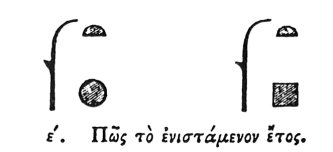 3
3Hieroglyphics of Horapollo, tr. Alexander Turner Cory, [1840], at sacred-texts.com
'To represent the current year, they depict [with the sign of the year?] the fourth
part of an ARURA: now the Arura is a measure of land of an hundred cubits. And when they would express a year they say a quarter [add the quarter?]: 1 for they affirm that in the rising of the star Sothis, 2 the fourth part of a day intervenes between the (completion of the solar year and the) following rising (of the star Sothis), because the year of the God [the solar year] consists of only 365 days; 3 hence in the course of each tetracterid 4 the Egyptians intercalate an entire day, for the four quarters complete the day.
II. Year as an interval of time.—Sh. 634, 633.
11:1 During the first fifteen days?
11:2 During the last fifteen days.
12:1 Substitute a square?
12:2 i.e. calculating according to Sothic time.
12:3 Salm. and De Pauw suggest, and Leem has ventured to insert in the text καὶ τετάρου, i.e. and a quarter, which entirely destroys the passage. Mr. Wilkinson says, "They had two years, one intercalated, the other not: the former was calculated from the Heliacal rising of the Dogstar, to that of the ensuing year, and was hence called the Sothic year: it had also the name of Squared year, from the intercalation; and when expressed in hieroglyphics a square is placed instead of the globe of the solar year, which last was used in the dates of their tablets, that refer to the reigns of kings or ages of individuals." Mat. Hier. part ii. p. 134.
12:4 The period of four Julian years.